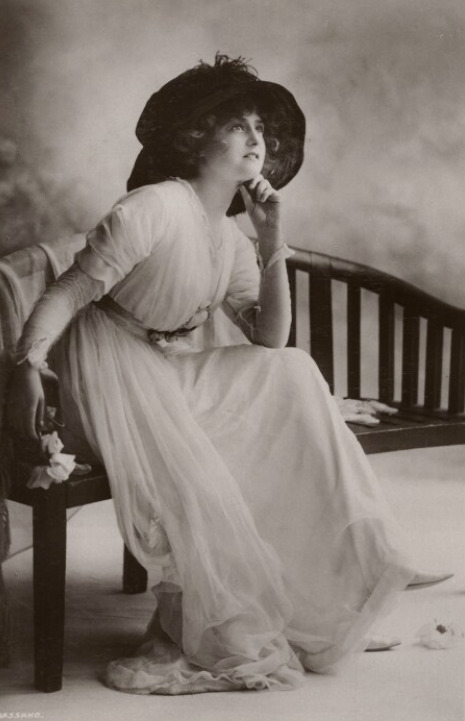Today, many actors and actresses of the 20th century are well remembered, and have achieved a legendary status in popular culture, such as Marilyn Monroe, Frank Sinatra, and Louise Brooks. While these individuals tended to be famous in their time, there is one in particular who was once the most celebrated, most revered icon in the world, yet seemingly overnight, was completely forgotten and appeared as if she had never existed.
This actress was Ms. Gabrielle Ray, the most photographed woman of the 1900s, and possibly the most photographed person of the 1900s altogether, being referred to as “The Most Beautiful Person in The World.” Unfortunately, today she remains practically forgotten when compared to other individuals of her century.
Early Life
Born as Gabrielle Elizabeth Clifford Cook on April 28th, 1883, in Cheadle, England, she was the fourth of six children. Her parents were William Cook and Anne Cook, with William being a wealthy iron merchant and judicial officer. Her career as an actress, dancer, and singer would begin quite early, as at the age of 10 she would star in the musical ‘Miami’ as a character named Eveleen in 1893, in the Royal Princess Theatre of London. Following her performance, she gained considerable attention from the local newspaper for her skillful dancing. However at the same time, her family was in turmoil. Her father appears to have had a history of financial mismanagement, being sent to prison in 1877 for defaulting on debts, in 1889 had filed for bankruptcy, in 1891 would be on trial for forgery of endorsements, and finally, in 1894, would divorce Anne. Gabrielle and her siblings remaining in their father’s custody.
There is no doubt that the divorce would have been hard for Gabrielle, being only eleven at the time, yet throughout the 1890s, she would star in many plays with minor roles, slowly gaining more and more prominence and local fame from newspapers, who constantly praised her for her dancing and singing. In 1899 at age fifteen, after starring in Sinbad the Sailor, theatre manager Ben Greet would invite her to tour with his theatre company, which she did so. From here it would begin to appear as if she ruled the world.

1901-1912
In 1901, at age eighteen, Gabrielle would understudy Gertie Millar, another young famous actress, with the two becoming close friends along with another equally famous actress, Lily Elsie. In Gabrielle’s later years, they would be among the only people in the world who expressed any form of care for her.
While Gabrielle’s fame was certainly increasing all across Britain, she still more often than not, found herself only playing minor or secondary roles. This would change when in 1902, she would star in Little Red Riding Hood, yet she would but play a secondary or minor character, she would play the namesake of the play, and would, to put it lightly stun audiences. This was when many in the audience took note of her sublime dancing skills, pristine voice, and beautiful appearance, and Gabrielle’s fame was all but assured. One man, Mr. Richard Wallis stated that he “chose to remember the enchanting Gabrielle Ray, (he) fell in love with her on sight”, and was captivated by her blonde hair and grey eyes.

This would lead to Gabrielle’s fame going from local, to global, with the French magazine ‘Temps’ referring to her as “The Most Beautiful Woman in The World”, with even some of the most powerful and influential people in the world such as Alfred Vanderbilt and King Manuel of Portugal expressing their undying admiration for her.
The mid 1900s would be the peak of her popularity, and with her having signed contracts with postcard companies who wished to use her image on their cards, she would become the most photographed woman of the decade. While some of Gabrielle’s colleagues and friends such as Ms. Lily Elsie did not maintain a very high opinion of her acting and singing, none could deny her skill as a dancer. One of her most stunning feats while dancing, came in the play ‘The Merry Widow’, during which she danced on a table being held up by four men, whilst doing handstands and high kicks, with the production running for over 700 shows.

By the 1910s, Gabrielle’s fame still had not wavered, in fact it only seemed to increase. Everywhere she went, she would be met with applause and adoration, and it would be impossible to buy a postcard without seeing her image. By her late 20s, it would be no surprise that there were many who wished to wed her, with her admirers being far and wide. In 1911 however, she would choose to marry Mr. Eric Raymond Loder, a wealthy businessman a few years younger than her. However, she could not have known what would happen to her as a result of this marriage.
Marriage to Eric Raymond Loder
In 1912, Gabrielle would leave the production of ‘Peggy’, having been engaged to Eric Raymond Loder, and on February 28th, she would be scheduled to marry him at St. Edward’s Roman Catholic Church. However, she did not attend the ceremony, leaving the crowd of hundreds and her future husband wondering what became of her. Newspapers had suspected that Gabrielle was “Too nervous” to appear given the hundreds of admirers, friends, and family present. This is obviously not true, considering as an actress she would regularly interact with large crowds. In truth, Gabrielle had refused to appear due to Eric not signing the prenuptial contract that would grant her financial security, with Eric claiming it was an oversight. However, three days later, the wedding would officially take place, and Gabrielle would be married to Eric.
From here, Gabrielle’s story becomes one of absolute tragedy. In 1913, Loder would cheat on her, and abandoned her. If the San Antonio Light’s June 22nd 1913 issue is to be believed, Loder found Gabrielle to be a “bore”, and demanded someone more “amusing”, leading to his abandonment of her. Gabrielle wrote letters to Eric, begging for him to return. After a court case, Gabrielle and Eric would officially divorce. Eric did not enter a defense.
Tragedy
From here, Gabrielle’s life becomes one of nothing but tragedy. Following her divorce, a number of American newspapers accused her of being the one who cheated, and denounced her. More lies would be spread by American media. In World War I, newspapers falsely claimed that Gabrielle wished to return to Eric.
In 1915, Gabrielle would make the decision to return to the stage, yet due to World War I, and the end of the Edwardian Era in 1912, she struggled to gain fame. Despite this, from 1915 to the early 1920s, Gabrielle was relatively well off, and a close friend, Roy Sambourne often took care of her and lent her money when she needed it. Yet no matter what she did, she could never achieve the fame she once enjoyed. She had once starred in London’s West End at the most prestigious and respected theatres in the world, yet in the 1920s, she would only find herself doing small charity performances, or variety tours, rather than any large scale production. In the 1900s, there had been thousands of postcards made with her image on them, and photos being taken seemingly every day of her. Yet in the entire 1920s, less than ten were taken of her. In 1924, she would leave the stage for good, never having achieved any degree of success.

Soon, her friends ceased loaning her money due to her struggling to pay them back, and Gabrielle began to live with her brother, unable to take care of herself, and resorting to drugs and alcohol, becoming addicted. Her mental state would only become worse and worse, until in 1936 she came back home, and in front of her brother, attempted to kill herself by jumping from a window. Although her brother prevented her, it became clear that Gabrielle had become a danger to herself, causing her to be sent to the Holloway Sanatorium after no family members offered to take her in.
According to author Guy Blythman, no relatives wished to look after her due to “the stigma of mental illness and the drugs involved”, it was also stated that Gabrielle was “not capable of looking after herself.” As for her former in-laws within the Loder family, they profusely rejected her. At about the time of Gabrielle Ray’s admittance to Holloway Sanatorium, Loder was partying with American yellow journalist William Randolph Hearst in Palm Beach, Florida according to newspapers, and had married his third wife
At Holloway Sanatorium, she was registered as ‘Mrs. Loder.’ Sadly, no family members would ever visit her, and in her early days at the sanatorium, she can only be described as being absolutely miserable. Her close friend, Roy Sambourne, would visit her twice in 1937, stating…
“To Holloway Sanatorium to see Gabs. Ghastly building, Gabs weeps all the time. I am upset and thankful to leave.”
On his second visit, he would state…
“Gabs in a pitiful state most distressing, and hangs round me. A dreadful 2 ½ hours there. When I think what she has been it is terrible.” This would be the last time he would ever visit her. Being such a close friend to Gabrielle, he was unable to bear the sight of seeing her in such a state.
Yet most thankfully, her stay was at the very least partly pleasant for her. Staff from the sanatorium recalled her having an “Infectious smile”, and that she “Enjoyed walks into the village nearby for shopping, and being taken on car rides, and sitting on the ground to feed ducks and squirrels.” One of her former nurses stated “She did not give any indication of the high life she must have enjoyed.” Despite no family members ever visiting her, she would be visited by colleagues and friends such as Gertie Millar and Lily Elsie. Sadly however, she would be more or less forgotten by the world. Throughout the 1940s to 1960s, her former colleagues often had reunions and press interviews, yet Gabrielle, never enjoyed such things. Yet although she may have been forgotten then, nowadays, it appears that her story, and her life, is being given the recognition it deserves. On May 21st, 1973, she would die at the age of ninety, having outlived all of her friends and family. Originally, her grave stated her as ‘Gabrielle Loder’, staining her with the name of the man who destroyed her life. Luckily, it would be changed to ‘Gabrielle Ray’ following a public campaign and a restoration effort of her grave. Today, she remains at Englefield Green Cemetery, and her birthplace is marked by a Blue Plaque, a sign used to denote historical places in the United Kingdom.







